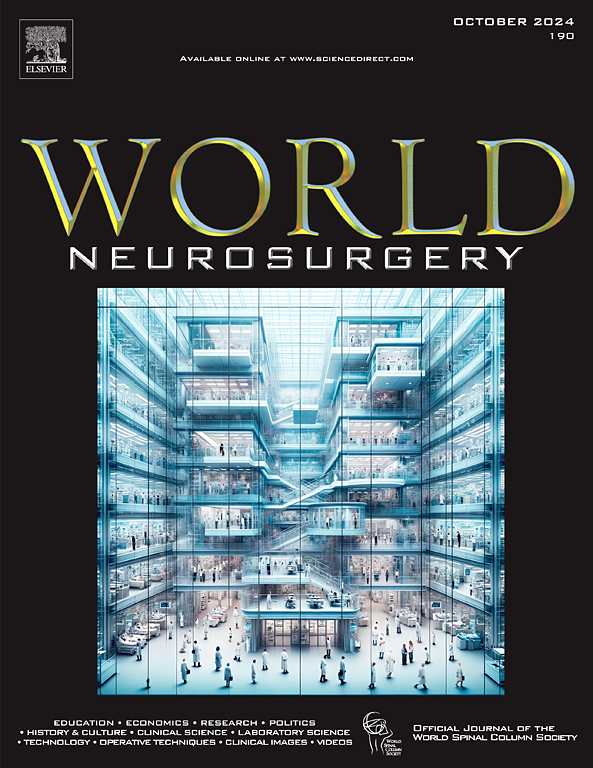Approaches for the Minimally Invasive Resection of Chiasmatic Cavernous Hemangioma: Analysis of 56 Cases in the Literature
IF 1.9
4区 医学
Q3 CLINICAL NEUROLOGY
引用次数: 0
Abstract
Background
Chiasmatic cavernous hemangioma (CCH) is a rare disease. Most cases are treated with surgical resection through approaches such as pterional and orbitozygomatic craniotomy. However, with advancements in surgical technique and heightened patient demand for improved postoperative quality of life, there have been reports in recent years exploring more minimally invasive surgical approaches, such as the subfrontal trans-eyebrow keyhole and endoscopic endonasal transsphenoidal approach. In this article, the cases of CCH in the reported literature are reviewed, the indications and techniques of minimally invasive surgery for the removal of CCH through the subfrontal trans-eyebrow keyhole approach are discussed, and the effects of different surgical approaches are analyzed.
Methods
We reviewed the literature on surgical cases of intracranial cavernous hemangiomas (with chiasma as the center) involving the visual pathway published from 2000 to 2023 in PubMed and other relevant databases; ultimately, 55 cases from 37 articles were retrieved, to which we added an additional case, making the total number of cases examined 56. We analyzed the patient's medical records, including pathological symptoms, relationship with the chiasma location, surgical approach, and prognosis.
Results
The analysis of the data of 56 cases indicated that most patients experienced a decrease in visual acuity (64.3%) and visual-field defects (58.9%). Gradual changes in pituitary function were also observed (43.8%). The surgical approach is determined by the location of the lesion. Over the past 5 years, although the pterional (46.4%) approach has remained the most common, the proportion of subfrontal (12.5%) approaches has gradually increased. In the case we report, we found that the lesion in the patient involved the anterior chiasma and the right medial optic nerve. The patient presented with acute visual deterioration, suggesting the possibility of hemorrhage in the hemangioma. We attempted the right-sided subfrontal trans-eyebrow keyhole approach and achieved complete resection of the cavernous hemangioma. Postoperatively, the patient showed improvement in visual acuity and visual field, with obvious recovery observed at the 3-month follow-up.
Conclusions
According to our results, the subfrontal trans-eyebrow keyhole approach for the resection of CCH is mainly suitable for cases in which the lesions are located above and anterior to the optic chiasm, the medial or superior aspect of the intracranial segment of the optic nerve is involved, and there is no invasion into the optic nerve canal. Compared with the traditional surgical approach, the minimally invasive subfrontal trans-eyebrow keyhole approach has demonstrated better clinical outcomes in the resection of CCH. However, according to the specific conditions of different patients, it is still necessary to comprehensively consider the choice of surgical approach. This study provides a valuable reference for further exploration of the treatment of CCH.
微创切除椎体海绵状血管瘤的方法:对文献中 56 例病例的分析。
背景椎管海绵状血管瘤(CCH)是一种罕见疾病。大多数病例都是通过手术切除治疗的,比如翼状开颅术和眶颧开颅术。然而,随着手术技术的进步和患者对术后生活质量要求的提高,近年来有报道探讨了更多的微创手术方法,如额下经眼眉锁孔和内窥镜鼻内镜下经蝶窦方法。本文回顾了文献报道中的 CCH 病例,讨论了通过额下经眼眉锁孔方法切除 CCH 的微创手术适应症和技术,并分析了不同手术方法的效果:我们查阅了PubMed和其他相关数据库中2000年至2023年发表的涉及视觉通路的颅内海绵状血管瘤(以椎体为中心)手术病例的文献,最终检索到37篇文章中的55个病例,并增加了1个病例,使研究病例总数达到56个。我们分析了患者的病历,包括病理症状、与椎弓根位置的关系、手术方法和预后:对 56 例病例数据的分析表明,大多数患者的视力下降(62.5%),视野缺损(53.6%)。垂体功能也逐渐发生变化(26.8%)。手术方法取决于病变的位置。在过去的 5 年中,虽然翼状区(42.3%)方法仍然是最常见的方法,但额叶下(15.3%)方法的比例逐渐增加。在我们报告的病例中,我们发现患者的病变累及前桥和右内侧视神经。患者出现急性视力衰退,提示血管瘤有出血的可能。我们尝试了右侧额下经眼眉锁孔入路,并完全切除了海绵状血管瘤。术后,患者的视力和视野均有所改善,3 个月的随访观察到明显恢复:根据我们的研究结果,额下经眼眉锁孔法切除海绵状血管瘤主要适用于病变位于视交叉上方和前方,累及视神经颅内段的内侧或上侧,且未侵犯视神经管的病例。与传统手术方法相比,微创额下经眉心锁孔法切除 CCH 的临床效果更好。但根据不同患者的具体情况,仍需综合考虑手术方式的选择。本研究为进一步探索 CCH 的治疗方法提供了有价值的参考。
本文章由计算机程序翻译,如有差异,请以英文原文为准。
求助全文
约1分钟内获得全文
求助全文
来源期刊

World neurosurgery
CLINICAL NEUROLOGY-SURGERY
CiteScore
3.90
自引率
15.00%
发文量
1765
审稿时长
47 days
期刊介绍:
World Neurosurgery has an open access mirror journal World Neurosurgery: X, sharing the same aims and scope, editorial team, submission system and rigorous peer review.
The journal''s mission is to:
-To provide a first-class international forum and a 2-way conduit for dialogue that is relevant to neurosurgeons and providers who care for neurosurgery patients. The categories of the exchanged information include clinical and basic science, as well as global information that provide social, political, educational, economic, cultural or societal insights and knowledge that are of significance and relevance to worldwide neurosurgery patient care.
-To act as a primary intellectual catalyst for the stimulation of creativity, the creation of new knowledge, and the enhancement of quality neurosurgical care worldwide.
-To provide a forum for communication that enriches the lives of all neurosurgeons and their colleagues; and, in so doing, enriches the lives of their patients.
Topics to be addressed in World Neurosurgery include: EDUCATION, ECONOMICS, RESEARCH, POLITICS, HISTORY, CULTURE, CLINICAL SCIENCE, LABORATORY SCIENCE, TECHNOLOGY, OPERATIVE TECHNIQUES, CLINICAL IMAGES, VIDEOS
 求助内容:
求助内容: 应助结果提醒方式:
应助结果提醒方式:


